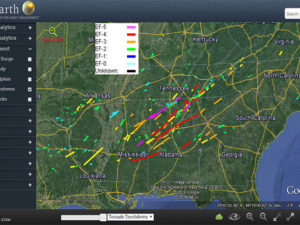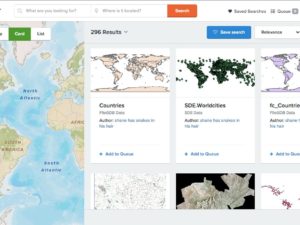BY JOSHUA HARTMAN / MANAGING PARTNER / RENAISSANCE STRATEGIC ADVISORS
BOARD OF DIRECTORS / U.S. GEOSPATIAL INTELLIGENCE FOUNDATION /
ARLINGTON, VA. WWW.RSADVISORS.COM
It is time to stop looking backwards—the world has changed and the coming revolution will force us to adapt. The GEOINT Revolution is upon us.
Throughout the GEOINT community’s existence, its core activities have centered on managing a flow of imagery products derived predominantly from overhead satellites. Describing geography and the static fixtures of the world around us have consumed our investment and supported our nation’s security.
Slowly, the fruits of this work have seeded the commercial world, sprouted and intertwined with outside interests to create a rapidly changing environment that will sweep up the GEOINT community. Today, we see an unprecedented democratization of geospatial information underpinned by an invisible layer of spatial and temporal information linking people, places and activities around the world. The reality is that, if we look deeply, we see GEOINT everywhere, used by everyone throughout our day—we just don’t realize it until we take a step back. Of course, the governments of the world use geospatial information, but so do our soccer moms, our marketers, our farmers, and our children.
This phenomenon is due to three underlying and enabling trends:
An increasingly data-centric environment,
The creation and mass proliferation of advanced analytics, and
The ease of access and intuitive visibility anytime, anywhere.
The continued convergence of these trends has caused a sudden and radical shift to our community. Welcome to the GEOINT Revolution.
A DATA-CENTRIC ENVIRONMENT
In the last year, we have created more data than previously existed in all of history and over the last decade the total size of the data universe has doubled every two years. The fact is that today we live in a data-centric environment; data is all around us and its tremendous influence on our lives will continue to grow in significance. Much of this data is open source and available at our fingertips, through a few clicks via the web and our phones. Each person, activity, and process generates a data trail of geospatial infor- mation in many forms and structures creating what I have previously called a “Data Bazaar.” The choices that exist in the Data Bazaar come in multiple forms, flavors, types, colors, and sizes. The exploration of the choices often creates more questions that then lead to more data. The community must determine how to adjust to this new data-driven environment.
As an example, only a handful of commercial remote sensing companies and the LANDSAT con- stellation provided access to geospatial data—almost exclusively imagery products. In the last decade, commercial investment has doubled the number of players in that market and proposed investment could double it again in only the next five years. The potential supply of imagery product could create constant and continuous collection of 100% of the globe.
Despite the potential flux of data coming from imaging satellites, another dynamic will make the environment more data-centric and propel the GEOINT Revolution. The majority of geospatial data today comes from our mobile phones and tablets, smart televisions, laptops and watches, multiple global navigation systems like GPS and Galileo, and even our automobiles and social media. Additionally, the Internet of Things, the spread of interconnected intelligence infrastructure, will generate the momen- tum of the Revolution as it is estimated that the size of the digital universe will grow 10X every two years rather than its current rate of 2X.
REVOLUTIONS ALWAYS INVOLVE CULTURAL CHANGE AND IMPACT REAL PEOPLE. THEY COME FROM THE CONVERGENCE OF MULTIPLE TRENDS THAT COLLIDE TO CREATE DRASTIC SHIFTS IN CULTURE.
ADVANCED ANALYTICS
Acknowledgement of the data-centric environment, with more data than our past tools could handle, has caused more focus on advancing our analytical world and automating as much of the process as is possible. Without it we would all drown in the data deluge. However, at this very moment around the world, automated analytical tools have been developed and are hard at work consuming this data to predict your next move through the use of complex models that can analyze the wider variety of more complex datasets.
The big advances in analytics represent their own sets of convergences involving hardware computing and storage improvements, increased algorithm sophistication, and maturity in predictive methods and machine learning. Yet the biggest advance has been in tailoring these concepts to address identifiable applications and solve specific problems. Beyond the obvious impact to the national security, advances in analytics are transforming entire sectors like transportation, energy, health care, marketing and sales, and finance—all of which have a significant geospatial component.
Adding to the democratization of geospatial data, advanced analytics mixed with the spread of
intelligent infrastructure does more than create more data. Whether mobile or static, it is centralizing and automating decision making at a local level in near real-time to provide customized responses to external and internal environments. This dynamic analysis across time and space is the essence of the GEOINT Revolution and continued advances are necessary to fuel it.
ACCESS AND VISUALIZATION
While the Data Bazaar has driven demand for advances in analytics, these advances would have little import or impact without access to and visualization of geospatial information. Several innovations have facilitated the Revolution in this area.
Despite its esoteric nature, common data standards and open architecture development allow a myriad of sources and systems to work together. This has eliminated proprietary stovepipes, establishing common foundations for interconnect and communication and enabling an unprecedented level of integration of data and knowledge. Platform-agnostic solutions have produced an environment where users can access and visualize geo-tagged information for their own specific use cases. Common mobile and smartphone applications leveraging geospatial information flood the consumer marketplace and add to the invisible layer of spatial and temporal data referenced earlier.
TODAY THE GEOINT COMMUNITY, MADE OF REAL PEOPLE, STAND AT THE CENTER OF SEVERAL TRENDS THAT HAVE ALREADY SHIFTED THE GROUND BENEATH ITS FEET.
The proliferation of communications infrastructure has propelled today’s access to geospatial data. Today, cellular and Wi-Fi networks have become universally available and, by many definitions, a public good, creating billions of, often unwitting, users of geospatial information. In the immediate future, commercial satellite investment will offer ubiquitous internet and global connectivity that will significantly expand access to and collection of geospatial data.
Examples include current providers of high through-put communications like Intelsat and SES as well as future constellations proposed by OneWeb and O3B (Other Three Billion, named after the number of users who do not currently have internet access).
In a seemingly unrelated market, Graphic Processing Units (GPUs) from the gaming industry have become an important part of multimedia computing and graphics processing. Advances in this arena have changed the user experience with respect to computing power and visualization. Spatial and temporal data, which once seemed cartoonish, now provide the user with authentic and life-like 2- and 3-D experiences. When integrated with geospatial data,ithasnot only significantly advanced the visualization of the data, but it has greatly enhanced the value and breadth of applications causing a dramatic shift in the number and types of geospatial products available on the market.
Closely linked to advancements in GPUs, augmented and virtual reality advancements have begun to make their mark on the GEOINT community. These markets have picked up remarkable momentum over the last five years moving from pedestrian activities to an estimated $5B-plus market in 2016. The integration of geospatial data into these systems will transform a number of applications from the common training and education experience to the travel and recreation industries. We will move beyond 3-D to the 4-D experience.
Advancements in technology can bring about dramatic change, but rarely can it start a revolution. Revolutions always involve cultural change and impact real people. They come from the convergence of multiple trends that collide to create drastic shifts in culture. Today the GEOINT community, made of real people, stands at the center of several trends that have already shifted the ground beneath its feet. It is unlikely that this disruption will be temporary or short lived. The GEOINT Revolution is here. What will you do to embrace it?





